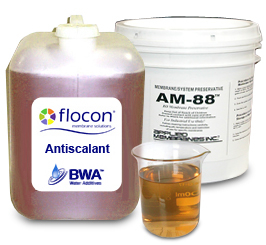Chemical Injection (Antiscalant) Faq

- What is the dose rate and method of injection for Flocon?
- Do Antiscalant & AM-88 have a chemical reaction?
- Can excessive Antiscalant foul the membranes?
- How does antiscalant work for a reverse osmosis water treatment
- What is the dose rate and method of injection for Flocon?
Dose Rate
The amount of Flocon required to inhibit scale formation depends on the degree of supersaturation of the insoluble salts at the point of highest concentration in the system. The degree of supersaturation in turn depends on the concentration of the ionic species in the feedwater, the overall salinity of the feed, the temperature of the feedwater, the percentage of the feedwater recovered as permeate and the type of membrane used for the application.
FLOCON Solution Concentration* %
Amount of Solution to be Injected per 1,000 Gallons of Feed Water, In Gallons
3 ppm
5 ppm100
0.003
0.005
50
0.006
0.010
20
0.015
0.025
10
0.030
0.050
* Use soft water or RO permeate to mix with Flocon.
Dose Method
Flocon should be added to a membrane system prior to the final cartridge filter. If media filtration or activated carbon is used, Flocon should be applied after these treatment stages.
Flocon should be delivered by dosing pump from a dilution tank, direct from the drum or from a bulk storage facility, into the feedwater at a rate that is determined by the size of the membrane system, the recommended dose rate and the delivery range of the dosing pump. It is recommended that the dosing pump be adjusted by the stroke length, while maintaining stroke frequency at a high level as possible to achieve even distribution of the Flocon in the membrane system feedwater.
CAUTION - Biological Activity:
Flocon contains a preservative that is effective up to a dilution of 1 part Flocon to 15 parts of system permeate water. General periodic cleaning of the dosing system is recommended as part of the planned maintenance program.
[Back To Top] - Do Antiscalant & AM-88 have a chemical reaction?
Antiscalant (organo-posphonate) and AM-88 (sodium meta-bisulphite for dechlorination) are sometimes both used for pretreatment.
There is no chemical reaction between the two chemicals.
[Back To Top] - Can excessive Antiscalant foul the membranes?
Excessive antiscalant can cause fouling of the membrane. This fouling can be cleaned by flushing the membranes with water at a pH of 2-3.
[Back To Top] - How does antiscalant work for a reverse osmosis water treatment
An antiscalant is a pretreatment injected into the feedwater before the feedwater enters the RO membranes. Its presence delays the reaction between calcium magnesium and bicarbonate. This results is scale not forming as the water is being purified by the RO. As the duration of the water in the membrane system is relatively short during the treatment, scale formation is prevented.
Click here for more details and ordering information on Antiscalant
[Back To Top]